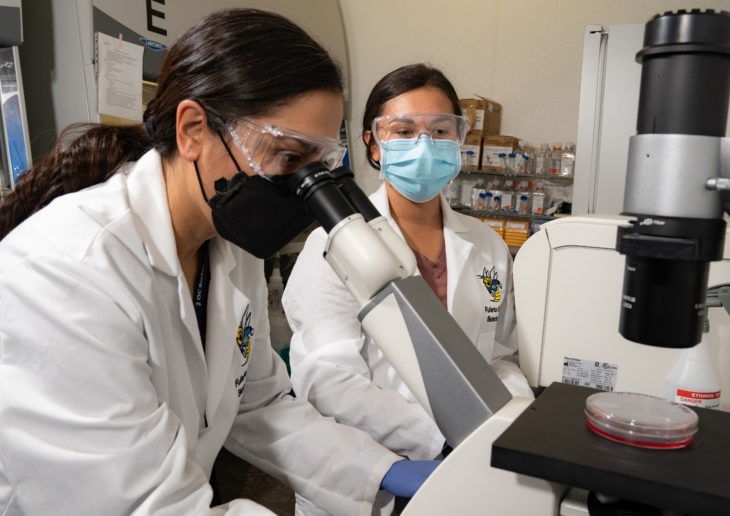Regional Community College Biotech Collaboration Benefits Students and Businesses Feature Story
December 23, 2022

Biotechnology is a wide-ranging and fast-growing field with jobs that run the gamut from biological technicians to chemical equipment operators. It’s an especially hot field in southern California, the state’s second-largest employer in biotech.
Orange County community colleges are addressing the need for biotech training through a four-college collaborative called OC Biotech Education, which has developed a tiered curriculum that allows students to earn certificates and a degree that leads to jobs in the flourishing biotech industry.
“There’s a massive need in the biotech industry,” said Emalee Mackenzie, director of the biotechnology program at Irvine Valley College. “There’s a huge job market and a definite shortage of skilled individuals.”
In California, more than 12,000 establishments offer jobs in biotech, which has about 310,000 jobs available in the field, the largest biotech employment base in the country, according to the 2021 report, Biotechnology Skilled Technical Workforce Needs Assessment, prepared by the Centers of Excellence for Labor Market Research. Surprisingly, more than two-thirds of the jobs in the life sciences sector—such as chemical technicians, inspectors, and testers—require some training or college, but not necessarily a four-year degree.
In addition to doing meaningful work such as medical research or in environmental science, the field also pays handsomely. The average annual earning for a biotech job in California is $95,750, with earnings of as much as $180,502 a year in biopharmaceuticals, according to the OC Biotech Education website.
In 2015, four Orange County community colleges—Fullerton, Irvine Valley, Santa Ana, and Santiago Canyon— joined together to meet this demand and help students find great careers. If a needed course isn’t offered at one college in a certain semester, a student can take the class at one of the other colleges so their education remains on track.
“It was more effective to work together,” Mackenzie said. “It benefits the students to alternate the offerings.”
The program also offers stackable certificates, which allow a student to build on the courses they have already taken to earn a higher-level certificate that can help them advance their careers and salaries.
The beginning-level certificate as a biotechnology lab assistant requires four courses, and students are eligible to obtain an internship after completion. Students can then find work in a variety of entry-level jobs (such as manufacturing assistant) earning $9 to $14 an hour.*
The mid-level certificate for biomanufacturing technicians requires four courses in addition to those required for the first certificate. Students with the mid-level certificate can work at jobs such as manufacturing operators or production assistants earning $11 to $25 an hour.*
The top-level certificate as a biotechnology technician requires students to choose among eight additional courses to earn an extra 13 to 16 units and leads to careers that can pay $13 to $26 an hour.* Additionally, students who complete their general education courses can earn an associate degree for transfer to a university.
The biotechnology education program was designed for many types of students:
- First-time college students seeking the schooling they need for a job in biotechnology.
- High school students who are taking college courses in biotech to get a jump on their higher education.
- University students who are at campuses that don’t offer biotech courses when they need them.
- Biotech employees looking to expand their knowledge so they can move up to higher-paying jobs in the field.
At the same time, OC Biotech Education is assisting students with disabilities so they can work in the industry. The program is working with employers to provide workers with disabilities the support they need, such as a lowered workbench for an employee in a wheelchair.
“They’re great employees. They just need some help to do their jobs,” Mackenzie said.
While many students come to the biotech field after an initial interest in more widely known medical occupations, Mackenzie hopes their efforts will help make biotech the first choice for more students.
“When students think they want to go into a health-related field, they think of a doctor or firefighter,” Mackenzie said. “But there’s so much more. If they want to develop vaccines, that’s biotech.”
*Source: https://www.ocbiotecheducation.org/




